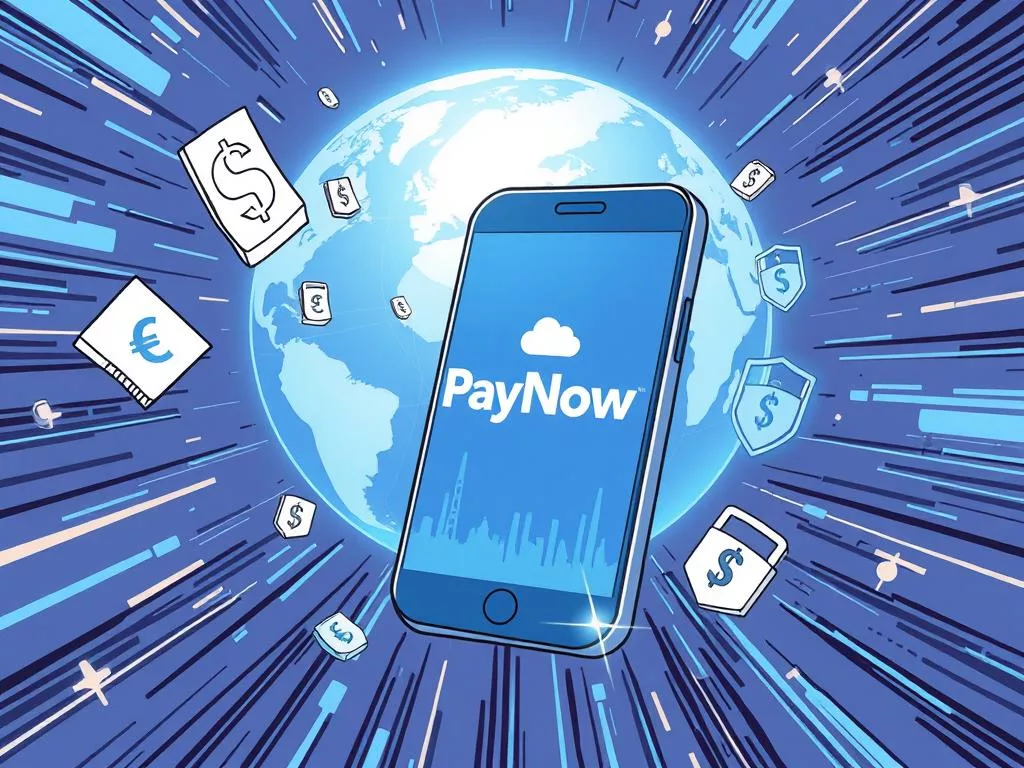PayNow was launched in Singapore in 2017. It changed how people make payments by using mobile numbers or NRIC numbers. Now, it also helps with international payments. It works with systems like PromptPay in Thailand and UPI in India for secure overseas transactions.
This move makes sending money across borders quick and safe. The Nexus Scheme, which includes these systems, aims to make everything more efficient. It wants to create a uniform system for all.
The scheme uses the latest digital payment methods and strong encryption. This ensures transactions are processed fast and are safe. Banks and tech partners from places like India, Malaysia, and the Philippines are helping. They want to make international payments as easy as local ones.
As PayNow grows, we’ll see faster, cheaper, and safer ways to send money abroad. This makes PayNow a top choice for smooth and reliable financial dealings.
Introduction to PayNow and Its Innovations
The Monetary Authority of Singapore (MAS) led the way in transforming Singapore’s payment systems with PayNow. It started to make local fund transfers easier. Then, it tackled the challenges of cross-border payments.
PayNow technology has brought new features like PayNow-PromptPay and PayNow-UPI. These links connect Singapore with Thailand and India, making real-time payments possible.

GIRO was introduced in 1984, starting the journey towards seamless payments. UPOS terminals in 2017 took it further. By 2018, the SGQR code made e-payments uniform across platforms.
But, integrating different systems into one was needed. So, the Nexus Scheme was created. It aims to unite regional payment systems, cutting costs and time while meeting global standards.
PayNow uses NRIC numbers, phone numbers, or UEN for instant transfers via FAST. This has boosted e-payments, with 97% of Singaporeans now using cashless payments. Mobile wallets have also gained popularity, with 1.8 million users.
The Central Banks of Indonesia, Malaysia, Philippines, Singapore, and Thailand have worked together. Their efforts highlight the need for better cross-border payments. The Nexus Scheme is set to change the game, making payments faster and more efficient globally.
More on global money transferalternatives
| Innovation | Implementation Year | Impact |
|---|---|---|
| Introduction of GIRO | 1984 | Simplified electronic fund transfers |
| UPOS Terminals | 2017 | Enhanced point-of-sale transactions |
| SGQR Code | 2018 | Standardized e-payments |
| Launch of PayNow | 2017 | Instant local fund transfers |
| FAST Implementation | 2014 | Near-instant bank transfers |
Guide to PayNow Overseas Transfer
Using PayNow for international transfers is easy and fast. Here’s a detailed guide on how to use PayNow for secure global money transfers.
Start by choosing the overseas transfer option in your local app. Then, enter the recipient’s mobile number and the amount and currency you want to send. The Nexus Scheme makes it simple by having the same steps everywhere, with fast and good rates.

To keep your transfer safe, PayNow uses biometrics or OTPs for verification. After checking, you can finish the transaction. Both you and the recipient get instant confirmation, making it secure and quick.
| Bank | Daily Transfer Limit |
|---|---|
| OCBC Bank | $1,000 SGD |
| UOB Bank | $20,000 SGD |
| DBS Bank | $1,000 SGD |
In 2021, PayNow’s monthly value hit 7.6 billion Singapore dollars. This shows it’s getting more popular for all kinds of transactions. New updates, like partial name masking from 16 March 2024, make users more confident in sending money.
The Nexus system makes sending money abroad easy and fast. It’s a big hit in Singapore, where PayNow is a big deal.
Businesses also win big with PayNow. They get easier transactions with QR codes and UENs, instant payments, lower costs, and better B2B relationships. These benefits make it a top choice for many sectors.
Drawbacks of Using Other Services Over PayNow
International money transfers vary a lot in fees, speed, and user experience. Bank wire transfers, a long-standing choice, have big fees, averaging $40 per transfer from places like Indonesia. The value of currencies like the Indonesian rupiah dropping by over 10% against the US dollar in 2022 makes things even harder for businesses. It takes 1-5 business days for bank wires to process, slowing down money moves.
Digital services like Wise, Remitly, and SingX offer alternatives for international money moves. But, they can have complex fees and may not always send money right away. This makes PayNow more attractive for both businesses and individuals. PayNow has grown a lot, reaching 4.5 million users by 2020. It also works with e-wallets like PayLah, supporting QR code payments at over 180,000 spots in Singapore and abroad.
PayNow is fast and has low fees, unlike many other services. It’s easy to use, with transactions in Singapore dollars just needing a mobile number or Virtual Payment Address. It also has strong security and follows international rules, making it a top choice for both local and international money moves. For more details, see this in-depth guide on PayNow for overseas transactions.
PayNow is efficient and cheap, which is why big names in Singapore use it. The upcoming Nexus system change will make it even better. In a world where fast, safe, and affordable money transfers are key, PayNow is a standout. It greatly reduces the problems faced by its competitors.

